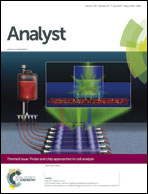Label-free colorimetric aptasensor for IgE using DNA pseudoknot probe†
Abstract
The development of simple and low-cost approaches to the detection of immunoglobulin E (IgE) would provide a method for the early diagnosis and prevention of atopic diseases. The current methods of detection are generally tedious, multi-step processes and are limited by the high cost of the labeled proteins. We describe here a label-free structure-switching colorimetric method for the simple measurement of IgE using DNA pseudoknot probes and gold nanoparticles. In the absence of a target the IgE aptamer probe adopts a pseudoknot conformation that dissociates a capture probe from the unmodified gold nanoparticles. However, when IgE binds to the aptamer probe, the pseudoknot is resolved, leading to a favorable hybridization between the 3′ terminal loop of the aptamer probe and the capture probe; this induces the aggregation of the gold nanoparticles. As a result, the colorimetric IgE sensor using this structure-switching mechanism is sensitive, specific and convenient, and the assay works even when challenged with complicated biological matrixes such as vaginal fluids. The proposed method is expected to be of great clinical value for IgE detection and could be used, after appropriate design, for sensing applications of other structured aptamers.


 Please wait while we load your content...
Please wait while we load your content...